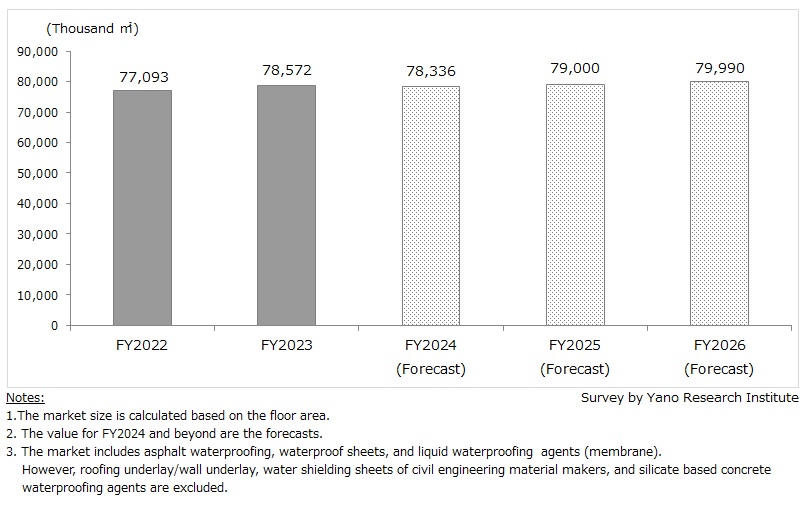No.3723
Waterproofing Materials Market in Japan: Key Research Findings 2025
Waterproofing Materials Market in FY2023 Estimated at 78,570,000 m2, 101.9% of Preceding Fiscal Year
Yano Research Institute (the President, Takashi Mizukoshi) has carried out a survey on the domestic market of waterproofing materials, and found out the market overview, the trends of market players, and future perspectives.

Market Overview
Size of the waterproofing materials market for FY2023 was estimated at 101.9% of the previous fiscal year to 78,570,000 m2 (based on the floor area).
Several factors contributed to the growth of the Japanese waterproofing market, including the resumption of construction projects that had been delayed or canceled during the pandemic, the increasing demand for the rejuvenation of office complexes and commercial facilities, particularly in metropolitan areas, and substantial investments in the development of large-scale manufacturing plants.
Noteworthy Topics
Addressing “Technician Shortage”
Waterproofing must be performed by "waterproofing technicians". Despite the growing demand for building construction, waterproofing contractors are unable to accept new waterproofing orders unless they have enough skilled technicians to apply the necessary materials and techniques. This means the increase in construction projects does not automatically translate into higher sales of waterproofing materials. In fact, the market has seen some contractors turning down orders due to a shortage of technicians. This represents a significant challenge in the waterproofing materials sector.
Moving forward, it is essential for waterproofing material suppliers to develop and introduce innovative products, methods, and machinery to effectively address the technician shortage.
Future Outlook
The market size of waterproofing materials for FY2024 is forecasted to decline to 99.7% of the preceding fiscal year to 78,336,000 m2 (based on the floor area).
Demand for waterproofing materials for detached houses is expected to decline, as the number of new housing starts is forecasted to decrease in the coming period. Meanwhile, demand for waterproofing in housing complexes and non-residential buildings is on the rise. This includes rejuvenation projects for office buildings in metropolitan areas, new construction of factories, large-scale refurbishments of condominiums, and metal roofing maintenance at manufacturing plants.
However, delays in construction projects have been observed in the phases leading up to waterproofing, driven by an overall shortage of personnel, rising construction material costs, and the introduction of a five-day workweek in the construction industry. Additionally, the shortage of technicians among waterproofing contractors and the shortened construction schedule due to heatwaves are impacting the sales of waterproofing materials. Considering all these factors, we forecast that the overall growth of the waterproofing materials market will be marginal going forward.
Research Outline
2.Research Object: Waterproofing material manufacturers, businesses related to waterproofing materials, and industry associations.
3.Research Methogology: Face-to-face interviews by our specialized researchers (including online interviews), survey by telephone, and literature survey.
Waterproof materials in this survey indicate construction methods and materials as listed below, which are used in construction to block rainwater and prevent water seepage/infiltration. However, it does not include roofing/wall underlay, water shielding sheets of civil engineering material makers, and silicate based concrete waterproofing agents.
- Asphalt (bitumen) waterproofing: Asphalt/modified asphalt (hot-applied liquid waterproofing, cold-applied liquid waterproofing, torch-on waterproofing)
- Waterproof sheets: Vulcanized rubber sheets, non-vulcanized rubber sheets, PVC sheets, EVA foam sheets, waterproof polyethylene sheets, polyurethane sheets, Thermoplastic Elastomer (TPE) membranes, Thermoplastic Polyolefin (TPO) membranes
- Waterproofing agents: Polyurethane, FRP, cement-based waterproofing (EVA/cement-acrylic based), acrylic polymer, other elastic waterproofing materials like resins/synthetic rubber, rubber modified asphalt, waterproofing agents for exterior walls (acrylic rubber, single liquid urethane)
<Products and Services in the Market>
Asphalt waterproofing, waterproof sheets, liquid waterproofing agents (membrane)
Published Report
Contact Us
The copyright and all other rights pertaining to this report belong to Yano Research Institute.
Please contact our PR team when quoting the report contents for the purpose other than media coverage.
Depending on the purpose of using our report, we may ask you to present your sentences for confirmation beforehand.